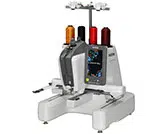Loading ...
Loading ...
Loading ...

BASIC EMBROIDERY
69
2
If the thread breaks or the bobbin thread
runs out while embroidering
If the thread breaks or the bobbin thread runs out while
embroidering, the machine will automatically stop. Since
some stitches may be embroidered with only one thread, go
back through the stitching to a point prior to the stoppage
before continuing to embroider.
If the upper thread breaks
a
Re-thread the upper thread. (page 62)
b
Touch .
The stitch navigating screen appears.
c
Touch and to go back through the stitching
to a point where stitches have already been
embroidered.
1 Each touch of this key moves one stitch back through
the stitching.
2 Each touch of this key moves ten stitches back through
the stitching.
If the needle bar is moved back too far through the
stitching, touch or to go forward through the
stitching.
1 Each touch of this key moves one stitch forward through
the stitching.
2 Each touch of this key moves ten stitches forward
through the stitching.
d
Touch .
The embroidering screen appears again.
e
Touch , and then press the “Start/Stop”
button to continue embroidering.
If the bobbin thread breaks or runs out
a
Touch , and then press the thread
trimming button.
The upper thread is trimmed.
b
Remove the stitches embroidered only with the upper
thread.
Pull the trimmed end of the upper thread.
• If the stitches cannot be cleanly removed, trim the
thread with scissors.
ADJUSTING WHILE
EMBROIDERING
(page 22):
An instruction video is available for this topic.
Note
• If [Upper and Bobbin Thread Sensor] is set to
[OFF], the machine does not stop until
embroidering is finished. Normally, the [Upper and
Bobbin Thread Sensor] should be set to [ON].
• Be careful when going back or forward through the
stitching since the embroidery frame moves at the
same time.
Note
• It is recommended to stitch over the top of the last
two or three stitches for complete coverage.
2
1
2
1
Loading ...
Loading ...
Loading ...
